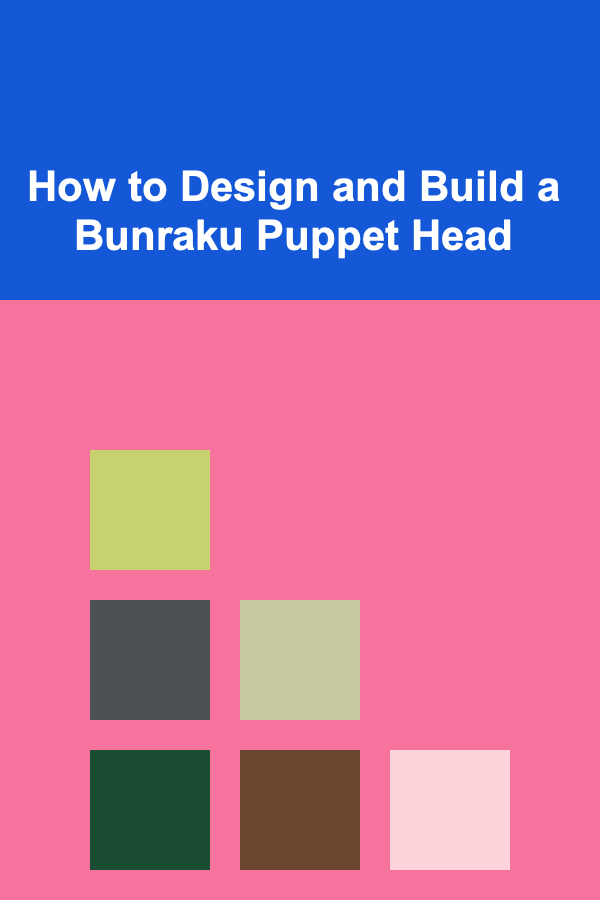
How to Design and Build a Bunraku Puppet Head
ebook include PDF & Audio bundle (Micro Guide)
$12.99$9.99
Limited Time Offer! Order within the next:

Bunraku is a traditional form of Japanese puppetry, known for its elaborate and detailed puppets, often controlled by multiple puppeteers. One of the most striking features of Bunraku puppets is their expressive, lifelike heads, which are designed to convey a wide range of emotions and actions. The process of designing and building a Bunraku puppet head involves not only artistic skill but also a deep understanding of the mechanics and functionality required for it to be operated effectively.
In this article, we will delve into the step-by-step process of designing and building a Bunraku puppet head. From understanding the role of the puppet's head to selecting materials and constructing the different components, this guide will walk you through the essential stages of creating a high-quality Bunraku puppet head.
Understanding the Bunraku Puppet Head
In Bunraku, the puppet's head is the focal point of its expressiveness. The face of the puppet plays a significant role in portraying the emotions, character traits, and intentions of the puppet. Unlike Western puppetry where the puppets may have simplistic or stylized faces, Bunraku heads are intricate, often with detailed eyes, mouths, and hair, all of which contribute to the overall realism and expressiveness of the puppet.
The construction of the head must allow for a range of motions, from blinking to opening and closing the mouth. The head is generally operated by one of the three puppeteers who control different aspects of the puppet. The complexity of the head's design is tied to the complexity of the puppet's performance. For example, the head must be able to convey subtle emotions like sorrow, joy, or anger, as well as respond to external stimuli like being startled or surprised.
Designing the Puppet Head
A. Determining the Character's Features
Before diving into the physical construction, it's crucial to design the head based on the character's appearance. Bunraku puppets can represent a wide range of characters, from noble figures to commoners, each requiring different facial features and styles. Here are some considerations for the design:
- Age and Gender: A young character might have a smooth face with minimal lines, while an older character could have wrinkles, scars, or a more weathered appearance. The gender of the character will also affect features like the shape of the jawline, nose, and brow.
- Emotion: Consider the emotional range of the character. A character who is constantly angry or sad might need a face designed with furrowed brows or a downturned mouth, while a joyful character might have an open, smiling expression.
- Cultural and Social Status: Bunraku puppets often reflect the status of the characters they represent. For instance, a samurai might have a more severe, dignified look, while a peasant might have a more simplistic and worn face. Details such as the shape of the eyebrows, the posture of the mouth, and even the size and shape of the eyes can indicate a character's status.
B. Sketching and Blueprinting the Design
Once the general look and character are determined, it's time to create a detailed sketch or blueprint of the puppet's head. The blueprint should include:
- Side and front views of the face to determine symmetry and proportion.
- Detailed sketches of the individual facial features such as eyes, nose, mouth, and ears. It's essential to show how each feature will be articulated and manipulated.
- Measurement dimensions that will guide the construction process, especially for sizing the head relative to the body.
This blueprint will serve as the guide for the sculpting and assembly phases.
Selecting Materials for the Puppet Head
The choice of materials for building a Bunraku puppet head is critical for both the aesthetic qualities and functionality of the puppet. Several materials are commonly used in the construction of Bunraku puppet heads, each with its own set of characteristics.
A. Wood
Traditionally, Bunraku puppet heads were made from lightweight woods like paulownia or cedar. Wood provides a natural aesthetic that suits the detailed carving and finishing required for the puppet's head. It's also durable and can be easily carved into the complex shapes necessary for a lifelike expression.
B. Papier-mâché
Papier-mâché is another common material used in the construction of Bunraku heads. It's lightweight, relatively easy to mold, and can create smooth, expressive surfaces once hardened. Papier-mâché is also cost-effective and can be layered to build up a solid, yet lightweight, structure for the head.
C. Clay or Resin
For more complex and detailed facial features, some artisans may choose to use clay or resin for sculpting. These materials allow for intricate detail, especially around features like the eyes, mouth, and nose. Resin, once hardened, is also durable and can be painted to resemble skin or other textures.
D. Synthetic Hair
The puppet's hair is an essential part of its appearance, especially for characters who have long or elaborate hairstyles. Synthetic hair can be used for this purpose, as it mimics the look of natural hair and can be styled according to the character's design.
Constructing the Puppet Head
A. Shaping the Head
Depending on the material chosen, the first step in constructing the head is shaping the basic structure. If using wood, this involves carving the face from a block of wood, carefully shaping the features to match the design. With papier-mâché, the base form may be created by layering the material over a mold or a pre-shaped framework.
If using clay or resin, the sculpting process involves building the facial features from scratch, molding them to the desired form. This step requires a steady hand and an eye for detail, as the features must be balanced and aligned.
B. Detailing the Features
Once the basic structure is in place, the next step is to refine the facial features. This step involves adding small details such as:
- Eyes: Eyes are often the most important part of a puppet's face. For realism, artists often use glass or plastic eyes, which are inserted into hollow spaces in the head. In some cases, the eyes may be movable or have the ability to blink or shift.
- Mouth: The mouth is typically a movable part that is controlled by the puppeteer. For Bunraku heads, the mouth can be hinged or mechanized, allowing it to open and close to match the character's speech or emotional state.
- Nose and Ears: These are sculpted and refined, but they tend to be less expressive than the eyes and mouth. However, they still play a role in contributing to the overall realism of the puppet.
- Facial Wrinkles and Details: For older characters, small lines, wrinkles, and other age markers are added to the face to create a sense of character depth.
C. Mechanizing the Head
The next step involves adding the mechanics that will allow the puppeteer to operate the head. Bunraku puppets typically have one puppeteer responsible for controlling the head, and the head must be designed to move in a way that feels natural.
- Jaw Mechanism: The mouth may be controlled by a string, lever, or pulley system that allows the puppeteer to open and close the mouth. Some heads use a more complex mechanical system to allow for more precise control over the mouth movements.
- Eye Mechanism: In some cases, the eyes may be movable, allowing the puppeteer to adjust the direction of the gaze. This is typically done using a simple mechanism that connects the eyes to a lever or rod.
- Blinking Mechanism: For added expressiveness, the eyes may also have a mechanism that allows them to blink. This could involve a small motor or string that pulls the eyelids closed.
The precise details of these mechanisms will depend on the design of the puppet, but the goal is to make the head as expressive and responsive as possible.
D. Assembling the Head Components
Once the mechanisms are in place, it's time to assemble all the parts. The head is often mounted onto a wooden or metal frame that connects it to the body of the puppet. The frame also supports the mechanisms used to control the mouth, eyes, and other facial features.
Once the assembly is complete, the head is carefully tested to ensure that all mechanisms are functioning properly and that the facial expressions can be controlled with ease.
Painting and Final Touches
After the head is constructed and all the mechanics are in place, the final step is painting and detailing. The painting process is essential for bringing the puppet to life. The skin tone of the puppet is typically painted in layers, starting with a base coat and followed by layers of detail to create depth and dimension. The eyes, eyebrows, and mouth are painted with care, adding small details like highlights in the eyes to make them look realistic.
For hair, synthetic materials are often used, and they are styled according to the character's design. In some cases, wigs or hairpieces are attached to the head, while for other characters, the hair may be painted directly onto the surface of the head.
Conclusion
Designing and building a Bunraku puppet head is a complex and time-consuming process that requires both artistic skill and technical knowledge. From the initial design phase to the final painting and detailing, each step is crucial for creating a puppet that is not only visually appealing but also highly functional. The head is the centerpiece of the puppet, responsible for conveying emotions, reactions, and the essence of the character. By following the steps outlined in this guide, you can begin to understand the intricate work involved in bringing a Bunraku puppet to life. Whether you are an experienced puppeteer or a newcomer to the world of Bunraku, this process provides the foundation for crafting puppets that are as expressive as they are functional.

How to Handle Return Shipping Fees in Your Dropshipping Business
Read More
How to Involve Local Businesses in Supporting Your Reunion
Read More
How to Keep Your Pet Hydrated in Hot Weather
Read More
How to Make a Spring Cleaning Checklist for Decluttering Your Home
Read More
How to Use Rugs and Carpets to Enhance Soundproofing
Read More
How to Generate Passive Income in Retirement
Read MoreOther Products

How to Handle Return Shipping Fees in Your Dropshipping Business
Read More
How to Involve Local Businesses in Supporting Your Reunion
Read More
How to Keep Your Pet Hydrated in Hot Weather
Read More
How to Make a Spring Cleaning Checklist for Decluttering Your Home
Read More
How to Use Rugs and Carpets to Enhance Soundproofing
Read More